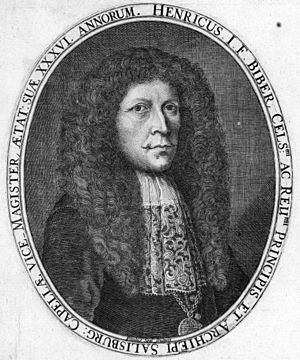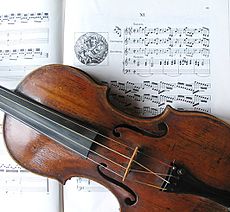Heinrich Ignaz Franz Biber facts for kids
Heinrich Ignaz Franz Biber (born August 12, 1644 – died May 3, 1704) was a famous Bohemian-Austrian composer and violin player. He was born in a small town called Wartenberg in Bohemia. Biber worked in different places like Graz and Kremsier. He later moved to Salzburg and stayed there for the rest of his life. He published a lot of his music but did not often go on concert tours.
Biber was one of the most important composers for the violin in history. He had amazing skills that allowed him to play very high notes and complex parts. He also explored special ways of tuning the violin, called scordatura. Biber wrote operas, church music, and music for small groups of instruments. He also created one of the first known pieces for solo violin, a huge passacaglia in his Mystery Sonatas.
During Biber's time, musicians all over Europe knew and copied his music. A music historian named Charles Burney called him the best violin composer of the 17th century. In recent times, Biber's music, especially the Mystery Sonatas, has become very popular again. Today, many people perform and record his works.
Contents
Biography
Heinrich Biber was born in Wartenberg, Bohemia (now in the Czech Republic). We do not know much about his early schooling. He might have studied at a Jesuit school in Troppau. He might also have learned music from a local organ player.
Before 1668, Biber worked for Prince Johann Seyfried von Eggenberg in Graz. After that, he worked for the Bishop of Olmütz, Karl II von Liechtenstein-Kastelkorn, in Kremsier. Biber's friend, Pavel Josef Vejvanovský, was the music director there. Biber was well-known and highly respected for his violin playing.
In 1670, Bishop Karl II sent Biber to Absam to buy new instruments. But Biber never went to Absam. Instead, he started working for the Archbishop of Salzburg, Maximilian Gandolph von Kuenburg. Bishop Karl and Archbishop Maximilian were friends. So, Karl did not punish Biber for leaving. However, he was very upset and waited until 1676 to officially let Biber go. Biber stayed in Salzburg for the rest of his life.
His music career and social standing grew in Salzburg. He started publishing his music in 1676. In 1677, he played for the Emperor Leopold I and received a reward. He became the deputy music director in Salzburg in 1679. Then, in 1684, he became the main music director. In 1690, the Emperor made Biber a nobleman. He was given the title Biber von Bibern. Later, the new Archbishop of Salzburg, Johann Ernst, made Biber a lord high steward. This was the highest social rank Biber achieved.
Biber got married on May 30, 1672, at Hellbrunn Palace near Salzburg. His wife, Maria Weiss, was the daughter of a merchant. They had 11 children, but only four lived to be adults. All of them were talented in music. His sons, Anton Heinrich (1679–1742) and Carl Heinrich (1681–1749), both played the violin at the Salzburg court. Carl Heinrich became the music director in 1743. His daughters, Maria Cäcilia (born 1674) and Anna Magdalena (1677–1742), became nuns. Anna Magdalena was a singer and violinist. In 1727, she became the director of the choir at her Abbey.
Biber died in Salzburg in 1704. He is buried in the Petersfriedhof cemetery.
Works
Biber's violin music was likely inspired by Italian composers like Marco Uccellini. It also took ideas from German composers like Johann Heinrich Schmelzer, who might have been Biber's teacher. Biber made violin playing much more advanced. He could play very high notes and use both hands and the bow in new ways. He was also great at counterpoint, which means writing several melodies that sound good together. He often wrote music where the violin played many notes at once.
One of Biber's biggest contributions was using scordatura. This means tuning the violin strings in unusual ways to create different sounds. Many of Biber's pieces also used special meanings with numbers or ideas, like in the Mystery Sonatas.
In the late 1600s, Biber was seen as one of the best and most important violinists in Europe. However, after he died, German violinists started to follow the style of Arcangelo Corelli.
Instrumental Music
Biber's best music using scordatura is in two collections. The first is from around 1676 and is known as the Mystery Sonatas or Rosary Sonatas. This collection was not published while Biber was alive. It has sixteen pieces: fifteen sonatas for violin and continuo (a bass instrument and keyboard) that tell the story of the Mysteries of the Rosary. There is also a long passacaglia for solo violin.
In the copies of this collection, each piece has a small picture showing the mystery it represents. Only the first and last pieces use normal violin tuning. All the others use different scordatura tunings.
Biber dedicated these sonatas to Maximilian Gandolph von Khuenburg. He wrote that he made them "to honor the XV Sacred Mysteries." Even though they were not published then, these works are his most famous today. They helped bring new interest to his music. Many violinists have recorded the entire set. Sonata 15 is famous because one of its tunes is very similar to Paganini's Caprice No. 24. It is possible that Paganini was inspired by Biber.
The second important work where Biber used scordatura is Harmonia artificioso-ariosa (1696). This was his last published collection of instrumental music. It has seven pieces for two instruments and continuo. Six of these pieces need scordatura tunings. Biber used this technique to create very complex music. Some pieces even have five different parts playing at once.
Biber's other published instrumental music includes Sonatae tam aris quam aulis servientes (1676) and Mensa sonora (1680). He also wrote many other pieces that were not published, like fantasias and balletti. One famous piece is the Battalia, a "battle" piece that sounds very modern. Another is the Sonata representativa, which imitates sounds of different birds and animals. Biber also wrote a piece called Sonata S Polycarpi for eight trumpets and drums.
Sacred Music
Biber did not just write for the violin. He also wrote a lot of sacred vocal music, such as masses, requiems, and motets. Many of these pieces used many choirs and instruments. He was inspired by the large Salzburg Cathedral.
One of his most famous large-scale works is the Missa Salisburgensis (1682). This is a huge mass for sixteen voices and 37 instrumentalists, making 53 parts in total. It was once thought to be by another composer, but now we know Biber wrote it. It includes not only strings but also oboes, cornetts, trumpets, and timpani.
Other large sacred works include Plaudite tympana à 53 (1682) and Missa Bruxellensis (1696). He also wrote Missa Sancti Henrici (1697) for his daughter Anna Magdalena when she became a nun. Even though Biber is known for these big works, he could also write for smaller groups. For example, Missa quadragesimalis is a simple piece for four voices without many instruments.
Selected recordings
- Requiem à 15 Vesperae à 32, Els Bongers, Anne Grimm, Kai Wessel, Peter de Groot, Marcel Reyans, Simon Davies, René Steur, Kees-Jan de Koning, Amsterdam Baroque Orchestra & Choir, Ton Koopman [1]
- "Sonata Representativa for violin & continuo in A major", The Zarjaz, La Leggenda Del Block, Editio Seconda, Traite Pour Marbre Neon Harpe Et Voix – Basilcia Records BA 005
- "Mensa sonora and Sonata representativa", Reinhard Goebel, Musica Antiqua Köln – Archiv Produktion (DG) 423701
- "The Rosary Sonatas", Richard Egarr, Andrew Manze, Alison McGillivray, Harmonia Mundi 907321
Images for kids
See also
 In Spanish: Heinrich Ignaz Biber para niños
In Spanish: Heinrich Ignaz Biber para niños







